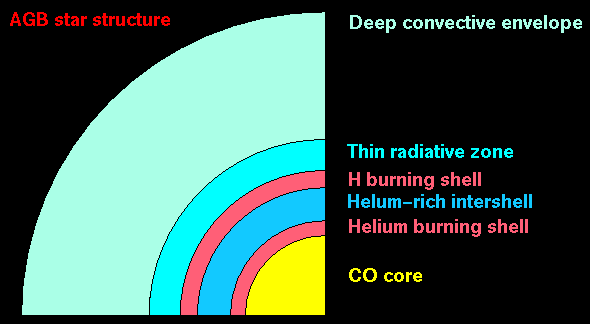Core Hydrogen Burning (M = 5 Msun and Z=0.02)
- Here we look at a star that is five times as massive as the Sun, but with a very similar composition.
- The figure below shows the HR diagram for the main H burning
phases.
The star starts on the zero-age main-sequence (ZAMS) and evolves off it and,
following the exhaustion of the core H supply, it begins to ascend the giant
branch. We will cover these in more detail below.
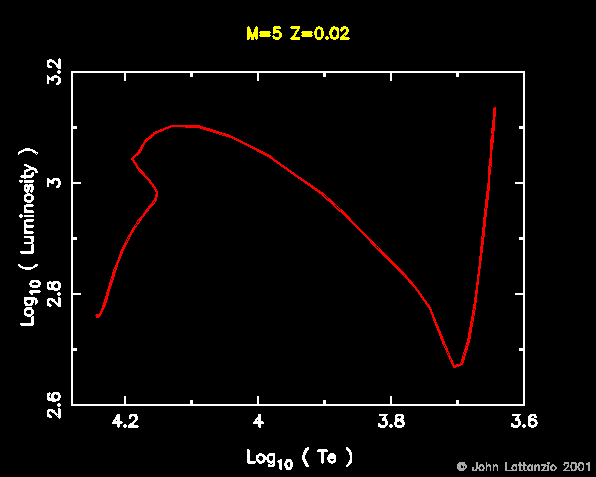
- This movie ( horizontal or vertical ) shows the hydrogen profiles (ie H mass-fraction versus mass) in the centre of the star as it evolves off the main-sequence. This phase ends when the central H supply is exhausted. Note that each frame corresponds to one of the symbols in the HR diagram. In contrast to the 1Msun model, this star has a convective core, where the composition is mixed to homogeneity. Convective regions are shown in red, radiative regions in green.
- Of course, the burning of H proceeds more quickly in the very centre, where the temperature is higher. And it produces He (strictly, He-4) as the H is destroyed, as shown in this movie
- Because we are using mass-fractions, then whatever H is burned will appear as He. This conservation of mass is nicely shown in the following movie which shows both H and He profiles during the H burning phase.
- H burning in this star occurs via the CNO cycles. This movie shows the conversion of C-12 into N-14 outside the core, and as H burning proceeds we see the increased ON cycling making more N-14 at the expense of O-16.
- The conversion of H into He raises the average mass per particle,
usually measured by mu. For a perfect gas the pressure is given by
P = rho R T/mu and since the pressure is constant (to first order) then as mu increases so must rho and T. That is, the centre of the star gets hotter and more dense, as show in in the following movies.
Shell Hydrogen Burning (M = 5 Msun and Z=0.02)
- After the central H supply is all converted into He-4, we see
the formation of a H-burning shell. This sits on the edge of the H-exhausted
core and progresses outward (in mass! not in radius!) as the star evolves.
The star now
moves relatively rapidly away from the main sequence and toward the giant
branch.
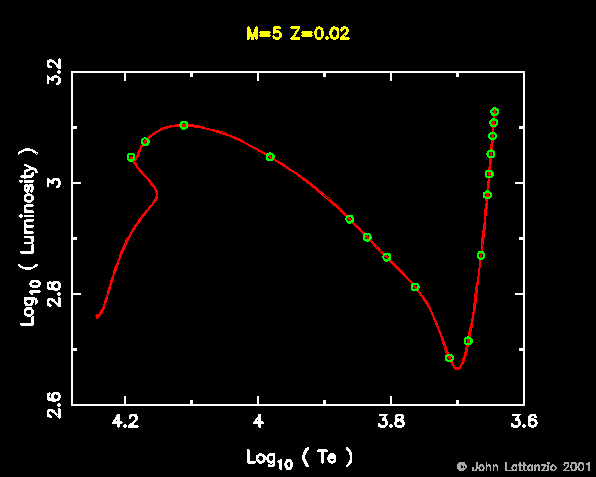
- We show next the temperature and density profiles during this
phase of evolution. These profiles are colour coded again: green where H=0,
blue where H has its surface value, and cyan in between, i.e. cyan in the
region of variable H, or the H-shell. The size of the H-exhausted core is
larger here than in the 1 Msun case, due to the convective core during the
earlier core H-burning phase. Hence just as the core starts to head towards
isothermality, the contraction and consequent gravitational energy release
keeps a substantial temperature gradient. In any event, not again how thin
is the H-shell in mass.
This evolution, and the advance of the H shell, is shown in the next movie ( horizontal or vertical ).
First Dredge-Up (M=5 Msun, Z=0.02)
- As the star ascends the giant branch it grows in radius and
the outer envelope cools. Convection becomes the dominant energy transport
mechanism due to the increased opacity at these lower temperatures. The
innermost edge of the convective envelope moves inward as shown below.
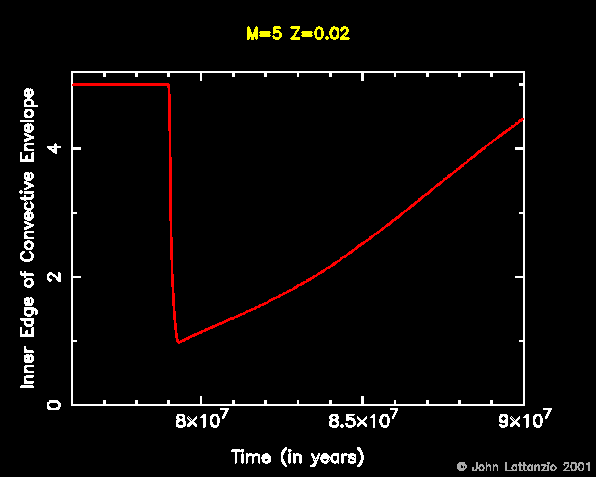
- As the convection extends inwards it can reach into regions where there was earlier H burning, and hence CNO cycling producing N-14 from C-12 and O-16. The inward advance of the convective envelope, also known as the First Dredge-Up, hence will be accompanied by the increase in the envelope abundance of N-14 and a decrease in the C-12 and O-16 content. This is shown in the next movie ( horizontal or vertical. ) Note that in contrast to the M=1 Msun case, the convection reaches into regions where there has been ON cycling as well.
- Detailed calculations of all nucleosynthesis, not just the species discussed here, are frequently compared to detailed observations of stellar abundances on the giant branch. In this way we have learnt a lot about mixing, including mixing beyond the predictions of standard models, such as those presented here. A reference or two will be added soon.
The next movie ( horizontal or vertical ) shows the corresponding position in the HR diagram.
Core Helium Burning (M=5 Msun, Z=0.02)
- Unlike the case at low masses, the core is hot and not as dense. Hence the star avoids the degenerate ignition seen in low masses, and ignites its e burning gently. The star now begins evolution with two energy sources: a He-burning core and a H-burning shell. This movie ( horizontal or vertical) shows the interior profiles of He as the star proceeds through the HR diagram. Note that we have colour-coded the He profiles here according to the H and He abundances.
- As He-4 burns it initially produces C-12. But once there is a
substantial amount of C-12 then we get O-16 from
C-12(alpha,gamma)O-16 as shown in the central abundances of C-12 and O-16, below.
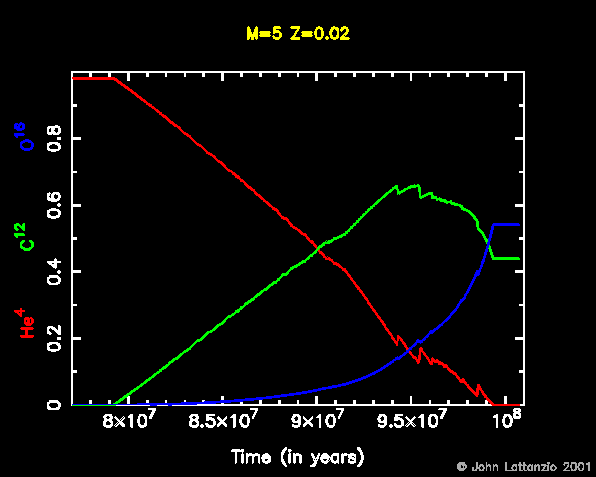
Overview of H and He Burning (M=5 Msun, Z=0.02)
- Now is a good time to review the overall evolution during the main H and He burning phases. The movies below will do this. There is a frame in each movie corresponding to each symbol in the HR diagram below.
- Firstly we show the H and He profiles. Watch the conversion of H into He, the advance of the H-shell and then the ignition of He-burning in the core. Watch the first dredge-up mix some of the burned regions.
- Next we show the He and C and O profiles. You can see the production of He during H burning and then the destruction of He and resulting conversion into C-12 and O-16.
- The next movie shows the temperature profiles during the evolution. The profiles are colour-coded to show the position of the H and He shells, and the He-exhausted core etc. There is a lot of information in this movie!
- The next movie shows the density profiles during the evolution. These profiles are also colour-coded, as in the temperature movie above.
- The next movie shows the luminosity profiles during the evolution. These profiles are also colour-coded, and show the H and He shells. Note that when the luminosity decreases with mass that the star is expanding, by absorbing some of the energy produced further in.
- And the next three movies show the last three with the
corresponding position in the HR diagram included.
- Temperature: horizontal or vertical.
- Density: horizontal or vertical.
- Luminosity: horizontal or vertical.
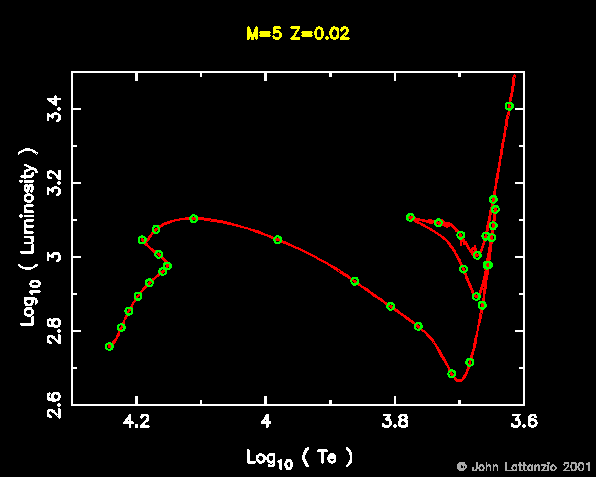
Second Dredge-Up (M=5 Msun, Z=0.02)
- Once the central helium abundance is exhausted the star will begin its ascent of the second, or asymptotic, giant branch. Initially the He shell produces a lot of energy and the H-shell is pushed out to lower temperatures. This shuts down the H-burning and further cooling causes the opacity to rise in the outer layers, and convection again extends inwards. As the convective envelope penetrates the erstwhile H-burning shell, it dredges to the surface the products of H burning (primarily He, of course, as well as N-14 from CNO cycling). This is called the Second Dredge-Up. This only happens for masses above about4 4 Msun. Lower masses will have a First Dredge-up, and possibly a Third Dredge-Up, but not a Second Dredge-Up!
- The next movie ( horizontal or vertical) shows the variation of the inner edge of the convective envelope with position in the HR diagram.
- This movie shows the H and He profiles during the same phase. Note that the dredge-up is very deep, reaching well into regions that have burned all their H into He. Toward the end of the movie you can see the He shell move into the frame from the left. Clearly the H shell will be re-ignited when the star's envelope contracts again, and it will be reborn at the current position of the H discontinuity resulting from the Second Dredge-up. This when the star begins its evolution with tow shell sources,they are very close together!
- Finally we show the CNO abundances during the Second Dredge-Up. We see that substantial amounts of N-14 are mixed to the surface, and hence the Second Dredge-Up sees a relatively large increase in N-14 and a simultaneous decrease in C-12 and O-16.
The Asymptotic Giant Branch (M=5 Msun, Z=0.02)
- Details of this evolution can be found
here. The schematic structure of
such a star is shown below.
